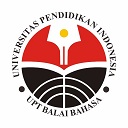Study on Acquisition of Japanese Adnominal Clauses Using Metalanguage Awareness in Indonesian Learners
Abstract
The theoretical research of Japanese linguistics is diverse. However, applying such research theory to Japanese language education does not necessarily help learners’ understanding. The purpose of this research is to concretely present the problems that arise from the gap between theory and practice in Japanese language research and Japanese language education. In this study, we examine the effect of the theoretical explanation of the Japanese adnominal clause on the learners’ understanding. We selected 10 second-year university Japanese learners as research subjects. They were selected because second-year learners already learn the adnominal clause. The adnominal clause was chosen because it has a considerably simple construction to check whether the learners can comprehend the meaning from those simple constructions. Since the theoretical explanation of linguistics is difficult for learners to understand, we gave a lesson using the learners’ awareness of language called “metalanguage awareness.” By using metalanguage awareness, learners are guided to understand the meaning through the comprehension of its grammatical construction using linguistic terms both in Japanese and their native language, which is Indonesian. As a result, it was found that even though adnominal clause construction is simple, the understanding of the meaning is not that simple. The understanding of adnominal clauses depends on the understanding of more basic learning items of “particles” and “clauses”, which learners still can’t grasp. We conclude that introducing such dependency in focus on form teaching method has the advantage for the teacher to check the degree of learners’ understanding. In this study, the adnominal clause can be used to check whether learners have fully understood the concept and usage of “particles” and “clauses” in Japanese. Since both concepts are very basic, it is important to take a step back and re-explain both concepts and usage so learners can use them correctly in the future.
Keywords
Full Text:
PDF (JPN)References
Achard, M. (2008). Grammatical Instruction in The Natural Approach: A Cognitive Grammar View. In Cognitive linguistics, second language acquisition, and foreign language teaching (165-194). De Gruyter Mouton.
Azarola, E. N. (2013). The Being and Becoming of Metalinguistic Knowledge: Rules and Categories of Grammatical Description as Functional Tools of The Mind. The metalinguistic dimension in instructed second language learning (221-242). Retrieved from Bloomsburry Collection.
Hideo Teramura. (1975). Rentai shūshoku no shintakusu to sono imi - sono 1 [Syntax of Union Modification and Its Meaning-Part 1]. Japanese Language and Culture-Osaka Foreign Language University International Student Special Course, 4, 71-119.
Hideo Teramura. (1980). Meishishūshoku-bu no hikaku' kunihiro tetsuya-hen. Ni~Tsu eigo hikaku kōza - bunpō ni. [Japanese-English Comparison Course-Grammar II]. Taishukan Shoten. 221-260.
Hiromi Saito. (2002). Rentai shūshokusetsu no shūtoku ni kansuru kenkyū no dōkō' [Trends in Research on the Acquisition of Attributive Form Clauses]. Language Culture and Japanese Language Education, 5, 45-69.
Japanese Language Education Teaching Materials Development Committee. (2005). Manabou! Ni hon go shokyū 1 [Let's Learn! Japanese Beginners 1]. Tokyo, Professional Education Publishing.
Kawatu, Aditio M. D. (2016). Analisis Kesalahan Penggunaan Klausa Relatif Mahasiswa Program Studi Pendidikan Bahasa Jepang Universitas Negeri Manado (Unpublished master’s thesis). Universitas Pendidikan Indonesia.
Katsunori Kanzawa. (2018). Rentai shūshoku kōbun no ninchi gengo-gaku-teki kenkyū [Cognitive Linguistic Study of Union Modification Syntax]. Unpublished Doctoral Dissertation. Kyoto University.
Keenan, E. & Comrie, B. (1977). Noun phrase accessibility and universal grammar. Linguistic Inquiry, 8(1), 63-99. Retrieved from jstor.org.
Noriko Nakajima. (2019). Nihongo kyōkasho ni okeru rentai shūshokusetsu no reibun bunseki [Example sentence analysis of adnominal clauses in Japanese textbooks]. Bulletin of Taisho University Research, 104, 133-150.
Serrano, R. (2011). From metalinguistic instruction to metalinguistic knowledge, and from metalinguistic knowledge to performance in error correction and oral production tasks. Language Awareness, 20(1), 1- 16. DOI:10.1080/09658416.2010.529911
Yukako Moriuchi. (2016). Gaikoku gogakushūsha no meta gengo nōryoku ni tsuite no kōsatsu [Considerations on Metalanguage Abilities of Foreign Language Learners]. French Language and Cultural Studies, 22, 1-9.
DOI: https://doi.org/10.17509/japanedu.v6i2.36622
Refbacks
- There are currently no refbacks.
Copyright (c) 2021 JAPANEDU: Jurnal Pendidikan dan Pengajaran Bahasa Jepang

This work is licensed under a Creative Commons Attribution-ShareAlike 4.0 International License.
 Published by:
Published by: Department of Japanese Language Education, Faculty of Language and Literature Education
Universitas Pendidikan Indonesia
 Online ISSN: Online ISSN:2528-5548 |

JAPANEDU: Jurnal Pendidikan dan Pengajaran Bahasa Jepang (e-ISSN:2528-5548) lisenced under a Creative Commons Attribution-ShareAlike 4.0 Internasional (CC BY-SA 4.0)

